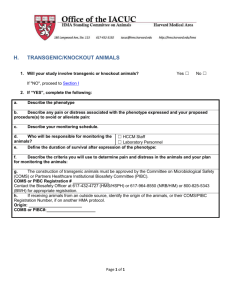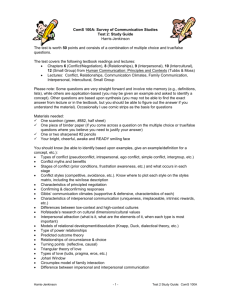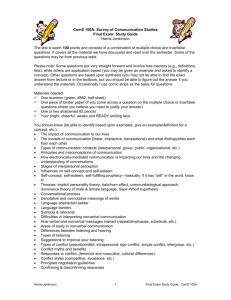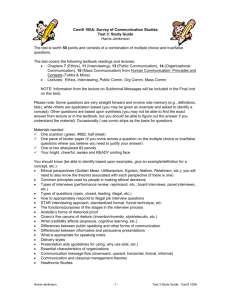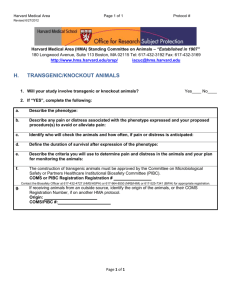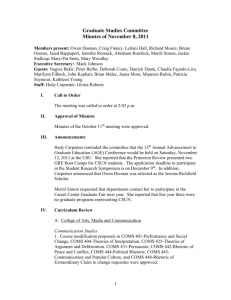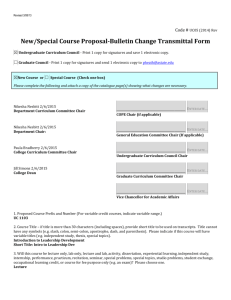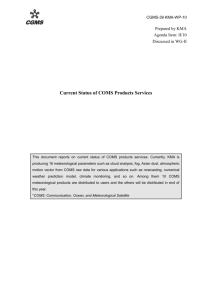Department of Communication
advertisement
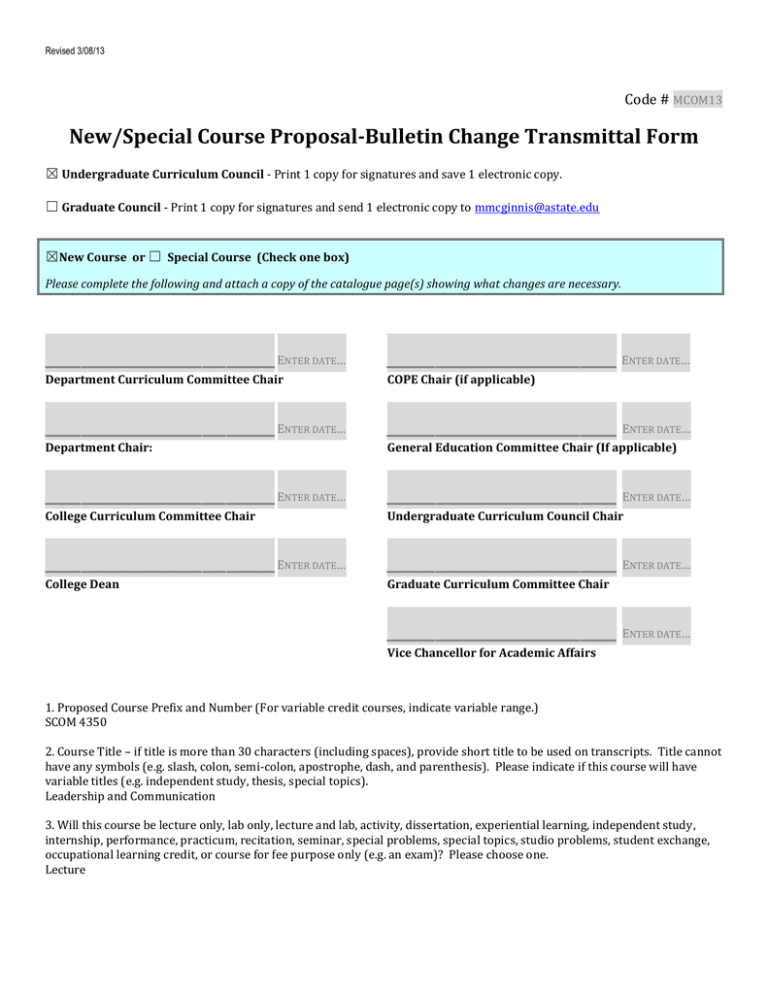
Revised 3/08/13 Code # MCOM13 New/Special Course Proposal-Bulletin Change Transmittal Form ☒ Undergraduate Curriculum Council - Print 1 copy for signatures and save 1 electronic copy. ☐ Graduate Council - Print 1 copy for signatures and send 1 electronic copy to mmcginnis@astate.edu ☒New Course or ☐ Special Course (Check one box) Please complete the following and attach a copy of the catalogue page(s) showing what changes are necessary. ___________________ ENTER DATE… ___________________ ENTER DATE… ___________________ ENTER DATE… ___________________ ENTER DATE… Department Curriculum Committee Chair Department Chair: ENTER DATE… ___________________ ENTER DATE… ___________________ ENTER DATE… ___________________ ENTER DATE… COPE Chair (if applicable) General Education Committee Chair (If applicable) College Curriculum Committee Chair College Dean ___________________ Undergraduate Curriculum Council Chair Graduate Curriculum Committee Chair ___________________ ENTER DATE… Vice Chancellor for Academic Affairs 1. Proposed Course Prefix and Number (For variable credit courses, indicate variable range.) SCOM 4350 2. Course Title – if title is more than 30 characters (including spaces), provide short title to be used on transcripts. Title cannot have any symbols (e.g. slash, colon, semi-colon, apostrophe, dash, and parenthesis). Please indicate if this course will have variable titles (e.g. independent study, thesis, special topics). Leadership and Communication 3. Will this course be lecture only, lab only, lecture and lab, activity, dissertation, experiential learning, independent study, internship, performance, practicum, recitation, seminar, special problems, special topics, studio problems, student exchange, occupational learning credit, or course for fee purpose only (e.g. an exam)? Please choose one. Lecture Revised 3/08/13 4. What is the grade type (i.e. standard letter, credit/no credit, pass/fail, no grade, developmental)? Standard Letter 5. Is this course dual listed (undergraduate/graduate)? Undergraduate 6. Is this course cross listed? (If it is, all course entries must be identical including course descriptions. It is important to check the course description of an existing course when adding a new cross listed course.) No 7. Brief course description (40 words or fewer) as it should appear in the bulletin. Role of leadership and communication in organizations and society 8. Indicate all prerequisites and if this course is restricted to a specific major, which major. (If a student does not have the prerequisites or does not have the appropriate major, the student will not be allowed to register). a. Are there any prerequisites? No b. Why? Course should be open to all students and majors and no prior knowledge of the subject is required. 9. Course frequency (e.g. Fall, Spring, Summer). Not applicable to Graduate courses. Fall 10. Contact Person (Name, Email Address, Phone Number) Marceline Hayes, mhayes@astate.edu, 870-972-2816 11. Proposed Starting Term/Year Fall 2014 12. Is this course in support of a new program? Yes/No If yes, what program? No 13. Does this course replace a course being deleted? Yes/No If yes, what course? No Has this course number been used in the past? Yes/No Submit Course Deletion Proposal-Bulletin Change Transmittal Form. 14. Does this course affect another program? Yes/No If yes, provide contact information from the Dean, Department Head, and/or Program Director whose area this affects. No 15. Justification should include: a. Academic rationale and goals for the course (skills or level of knowledge students can be expected to attain) Students will have an advanced understanding of critical communication skills and leadership. It would prepare students for graduate work in communication leadership. b. How does the course fit with the mission established by the department for the curriculum? If course is mandated by an accrediting or certifying agency, include the directive. Revised 3/08/13 The Department of Communication’s mission is founded upon critical thinking and problem solving. Students will learn to think critically, strategies used in negotiating and the role communication plays in effective leadership and management strategies. c. Student population served. All upper level students at ASU d. Rationale for the level of the course (lower, upper, or graduate). This course is created at the “4000” level to prepare students for possible graduate work in communication leadership. The level of theory in this course is beyond a more foundational “3000” level course but does not reach expectations for graduate work.. 16. Outline (The course outline should be topical by weeks and should be sufficient in detail to allow for judgment of the content of the course.) Week 1: Course Introduction Week 2: What is leadership communication? Week 3: Leadership Communication, Purpose, Strategy and Structure Week 4: Common Leadership & Follower Styles Week 5: The Language of Leaders Week 6: Creating Written Leadership Communication Week 7: Leadership Presentations Week 8: Graphics and PowerPoint with a Leadership Edge Week 9: Trait, State and Functional Leadership Week 10: Transformation & Charismatic Leadership Week 11: Power & Influence Week 12: Leadership in Groups/Teams, Organizations & the Public Sphere Week 13: Leadership Communication & Ethics Week 14: Leadership Book Review Presentations/Leadership Development Week 15: Final Exam 17. Course requirements (e.g. research papers, projects, interviews, tests, etc.) Research papers, projects and exams 18. Special features (e.g. labs, exhibits, site visitations, etc.) No 19. Department staffing and classroom/lab resources (Will this require additional faculty, supplies, etc.?) No 20. What is the primary intended learning goal for students enrolled in this course? Understand the role of communication in leadership positions and organizations 21. Reading and writing requirements: a. Name of book, author, edition, company and year Barrett, D.J. (2011). Leadership Communication. (3 rd Ed.). New York: McGraw-Hill. b. Number of pages of reading required per week: 40 c. Number of pages of writing required over the course of the semester: 40 22. High-Impact Activities (Check all that apply) ☒ Collaborative assignments ☐ Research with a faculty member Revised 3/08/13 ☒ Diversity/Global learning experience ☒ Service learning or community learning ☐ Study abroad ☐ Internship ☐ Capstone or senior culminating experience ☐ Other Explain: Enter text... 23. Considering the indicated primary goal (in Box #20), provide up to three outcomes that you expect of students after completion of this course. Outcome #1: (For example, what will students who meet this goal know or be able to do as a result of this course?) Label, understand and differentiate among trait, state and functional leadership in the workplace. Learning Activity: (For example, what instructional processes do you plan to use to help students reach this outcome?) Students will shadow and interview leaders in specific organizations. Assessment Tool: (For example, what will students demonstrate, represent, or produce to provide evidence of their learning?) Students will write a report providing examples of each observed leadership style. (Repeat if needed for additional outcomes 2 and 3) Outcome #2: Analyze the purpose, context and strategies of communication in corporate settings. Learning Activity: Students will shadow “small businesses” and record the different communication strategies they observe. Assessment Tool: The students will analyze the data to create a report identifying the observed purpose, context, and strategies of communication. The instructor will assess the accuracy of the analysis through a comparison of recorded data and analysis. 24. Please indicate the extent to which this course addresses university-level student learning outcomes: a. Global Awareness ☐ Minimally ☐ Indirectly ☒ Directly b. Thinking Critically ☐ Minimally ☐ Indirectly ☒ Directly c. Using Technology ☐ Minimally ☒ Indirectly ☐ Directly Revised 3/08/13 From the most current electronic version of the bulletin, copy all bulletin pages that this proposal affects and paste it to the end of this proposal. To copy from the bulletin: 1. 2. 3. 4. 5. 6. 7. 8. 9. 10. Minimize this form. Go to http://registrar.astate.edu/bulletin.htm and choose either undergraduate or graduate. This will take you to a list of the bulletins by year, please open the most current bulletin. Find the page(s) you wish to copy, click on the “select” button and highlight the pages you want to copy. Right-click on the highlighted area. Click on “copy”. Minimize the bulletin and maximize this page. Right-click immediately below this area and choose “paste”. For additions to the bulletin, please change font color and make the font size larger than the surrounding text. Make it noticeable. For deletions, strike through the text, change the font color, and enlarge the font size. Make it noticeable. Department of Communication Associate Professor Marceline Hayes, Interim Chair Professors: Fowler Associate Professors: Hill Assistant Professors: Clark, Hall, Harper, Pan, Randle, Thatcher Instructors: Moskal, Scott The Department of Communication offers a Bachelor of Arts in Communication Studies and a Bachelor of Science in Strategic Communication. Students can emphasize in advertising or public relations in the Strategic Communication Program. COMMUNICATION STUDIES PROGRAM: Communication Studies focuses on the ways that people make use of both verbal and nonverbal messages to generate meanings within various contexts, cultures, and media. Since 75% of a person’s day is spent communicating in some way, the importance of being able to communicate clearly cannot be overemphasized. Communication skills are essential to personal satisfaction and academic success, as well as employment. Courses provide a strong theoretical foundation in communication as well as an emphasis on improvement in practical communication skills. Majors in Communication Studies have the flexibility to focus on specific areas of interest while obtaining a thorough understanding of communication. Students may also choose to become involved with departmental activities such as the debate team or Lambda Pi Eta, the national honor society for communication students. STRATEGIC COMMUNICATION PROGRAM: Strategic Communication uses public relations, advertising, social media, and organizational communication to build mutually beneficial relationships with key stakeholders. Effective organizations use strategic communication to help achieve their goals and objectives and recognize that groups inside and outside the organizations are critical to their success. Communication is strategic when it uses research and evaluation to determine how goals and objectives are effectively reached. Students graduating from this program will know and understand how to use advertising, public relations, social media, branding, crisis communication, media relations, research methods and evaluation tools to help organizations communicate with their publics. They will be prepared to work for companies big and small, governmental agencies, and nonprofit organizations such as universities, hospitals, museums and NGOs. Students earning a Bachelor of Science in Strategic Communication must complete the following: Revised 3/08/13 1. Take at least 72 hours outside of the three Bachelor of Science degrees offered in the College of Media and Communication. 2. A minor outside of the College of Media and Communication. The minor must be approved by the student’s advisor. 3. Earn no more than three hours of internship credit towards the 120 hours required for graduation. 4. Take a senior exit exam on the study day prior to final exams of his or her last semester of enrollment. 5. Complete an exit survey and submit a resume prior to graduation. P. 283 Major in Communication Studies Bachelor of Arts Emphasis in Organizational Communication University Requirements: See University General Requirements for Baccalaureate degrees (p. 40) First Year Making Connections Course: UC 1013, Making Connections General Education Requirements: See General Education Curriculum for Sem. Hrs. 3 Sem. Hrs. 35 Baccalaureate Degrees (p. 82) Students with this major must take the following: CMAC 1003, Mass Communication in Modern Society COMS 1203, Oral Communication (Required Departmental Gen. Ed. Option) College of Media and Communication Core Courses: Sem. Hrs. (See Beginning of Media and Communication 4 Section) Major Requirements: Sem. Hrs. Revised 3/08/13 COMS 2313, Communication Theory 3 COMS 2243, Principles of Argumentation 3 COMS 2373, Introduction to Interpersonal 3 Communication 3 Communication Studies Electives (6 hours must 9 be upper-level) AD 3023, Principles of Advertising COMS 2253, Introduction to Health Communication COMS 3203, Business and Professional Communication COMS 3243, Principles of Persuasion COMS 3373, Gender Communication COMS 3253, Principles of Listening COMS 4203, Small Group Communication COMS 4243, Interpersonal Communication COMS 4253, Intercultural Communication COMS 4263, Organizational Communication COMS 4323, Communication in Personal Relationships COMS 4373, Conflict Resolution COMS 4383, Computer Mediated Communication COMS 4403, Health Communication COMS 4423, Narratives in Health and Healing PR 3003, Principles of Public Relations PR 4603, Crisis Communication Sub-total 30 Revised 3/08/13 Emphasis Area (Organizational Communication): COMS 3203, Business and Professional Communication COMS 4203, Small Group Communication COMS 4263 Organizational Communication COMS 4443 Communication and Leadership 12 45 Electives Total Required Hours: 120 P. 284 P. 487 COMS 2373. Introduction to Interpersonal Communication A study of interpersonal communication. Prerequisite, COMS 1203. Spring. COMS 3203. Business and Professional Communication Communication needs of people in business and professional settings. Fall, Spring. COMS 3211. Intercollegiate Debate Study and practice of intercollegiate debate. May be repeated for credit. Demand. COMS 3243. Principles of Persuasion Theory and practice of persuasion as an instrument in motivating human conduct. Fall. COMS 3253. Principles of Listening Principles of listening in the communication process, emphasis on listening improvement. Fall, even. COMS 3363. Communication Research Methods Principles of listening in the communication process, emphasis on listening improvement. Fall, even. COMS 3373. Gender Communication Study of the interrelationship between communication and gender in various contexts. Spring, odd. COMS 3433. Communication Criticism Provides critical approaches from the humanistic condition engaging media, public discourse, and interpersonal communication. Prerequisites, COMS 1203, or PHIL 1503 or PHIL 1103. Summer. COMS 4203. Small Group Communication Group and conference techniques for classroom, business, and professional situations. Spring, Summer. Revised 3/08/13 COMS 4243. Interpersonal Communication Emphasis on increasing students capacity for openness, sensitivity, and objective appraisal. Fall, Summer. COMS 4253. Intercultural Communication Identification of barriers and breakdowns to communication among cultures. Spring. COMS 4263. Organizational Communication Dynamics and theories of communication within an organization. Spring, even. COMS 431V. Special Problems Prerequisite, permission of instructor. May be repeated twice with different topics. Demand. COMS 4373. Conflict Resolution Conflict as a communication variable COMS 4323. Communication in Personal Relationships The course covers interpersonal communication in the context of personal relationships, such as romantic relationships, friendships, professional relationships, and family relationships. Fall, odd. created through interpersonal interaction in dyads, small groups, families, and organizations. Dual listed SCOM 5373. Summer. COMS 4383. Computer Mediated Communication This course considers how identities, relationships and communities are created and influenced by our use of computers and the internet. We will gain understanding of these processes by engaging new media scholarship and activities involving different forms of new media. Dual listed as SCOM 5383. Prerequisite, COMS 1203. Spring. 488 COMS 4403. Seminar in Health Communication Study of the major cultural, interpersonal, and public communication issues affecting health communication. Spring, odd. COMS 4423. Narratives in Health and Healing Explores the social construction of health, illness, and healing through the study narrative. Dual listed as SCOM 5423. Spring. COMS 4443 Communication and Leadership Leadership and communication in organizations and society. Public Relations (PR) PR 3003. Principles of Public Relations Nature and theoretical foundation of public relations, its role in society, practitioners and dynamics of the process. Fall, Spring, Summer. PR 3013. Public Relations Tools and Techniques Analysis and application of public relations tools and techniques with an emphasis on public relations writing, specialized publications, and strategy for working with corporate and noncorporate organizations. Prerequisite, CMAC 2003, MMJ 2013, and PR 3003. Fall, Spring. PR 4013. Public Relations Practicum and Professional Development Advanced PR course requiring application of skills in supervised work with various businesses, institutions, organizations and social agencies. Student will work a minimum of 10 hours per week outside the classroom with assigned workplace mentor. Consent of instructor required. Fall, Spring. PR 4023. Public Opinion, Propaganda and the Mass Media Survey of public opinion formation and change, with special attention to the role of the mass media in the creation and use of public opinion and propaganda. Fall. PR 4033. Public Relations Case Studies and Campaigns Study of recent public relations cases and campaigns involving business, industry, institutions, and government. Students create a comprehensive public relations campaign for a given client. Prerequisites, MMJ 3363, PR 3013, and PRAD 3143. Spring. PR 4113. Integrated Marketing Communications Focuses on the strategic integration of various channels and methods of communications for the purpose of delivering key messages to diverse target audiences in order to elicit specific responses, create a dialogue and engender relationship building. Prerequisite, AD 3023, or PR 3003, or MKTG 3013. Fall, Spring.
